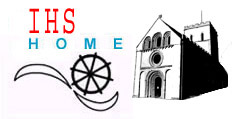
The Iffley History Society
 |
|
|||||
|
1955
Article on Iffley Life |
|
|
IFFLEY, A VILLAGE –
BUT IN THE CITY You notice the difference as soon as you get off the bus and walk along Iffley Turn: From the continuous roar of heavy traffic to silence broken only by the birds in the trees, from the town to the open country, the change is abrupt and startling in its suddenness. "Iffley village Only" says the sign-post. There is no through road. There are no buses. By some fantastic miracle Iffley remains both in appearance and in character a real old, very old, English village. It has become embedded among its modern surroundings, like a pearl in an oyster, but it has most surprisingly, not allowed itself to be submerged by them. Church Way is the appropriate name for the quiet road that leads to the village, for Iffley's crowning glory and outstanding architectural feature is undoubtedly her magnificent late Norman church. On the way to it I first came to a number of solid pleasant houses each lying back from the road, embowered among trees, with spacious grounds and here and there between the houses, open fields giving lovely vistas of views down the hill over the poplar-fringed Thames to the rising ground leading to Bagley Woods. The most notable of these houses is the Old Priory from which I mean, I was told, a subterranean passage runs to the Old Malt House which seems an unexpected destination if it was, in fact, originally a nunnery. AT "THE TREE" |
|
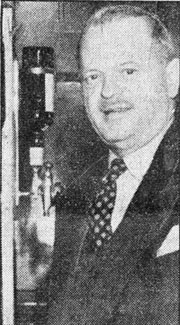 |
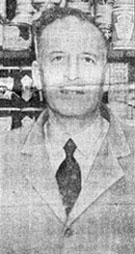 |
|
Mr. Webber, landlord of the Tree Hotel. |
Mr.
W.Gibbs, whose shop is used by customers almost as a club |
The village stocks used to stand here, but they, like many other ancient landmarks, have disappeared. On the other side of the road stand the picturesque timber and plaster Tudor cottage, with black beams, a huge stone hearth and low ceilings, where Miss Jones supplies appetising home-made dishes for teas and suppers. The visitor to Iffley is certainly well catered for internally. VILLAGE ATMOSPHERE "Iffley, "said Mr Gibbs, smiling, "is very much still a village, and that's the way we like it, and that's the way we mean to keep it. Everybody knows everybody else. We are all good neighbours in Iffley, and though unfortunately many, but by no means all, of the old Iffley families are dying out, the newcomers become quickly absorbed very quickly and seem to inherit the old village spirit. We haven't got a bus, and we don't want one. We haven't got a through road, and we don't want one. We're all right as we are." Certainly the children seem to be all right as they are. The otherwise quiet road seemed to be filled with small boys and girls learning to ride new bicycles. I felt that it was just as well that it is a cul-de-sac. They were all over the place, and certainly in blissful ignorance of the Highway Code. Incidently, they all saluted me in true village fashion as I passed. They were besieging the little sweetshop known as "The Old Stores" in such numbers that I didn't get a chance to ask the proprietor, Mr Goodwin, whether he felt that Iffley was still a village. Instead I crossed the road to the village pub, "The Prince of Wales", which is the only inn I know which has no front door. I walked round to the back and found myself on the verge of the steps leading down to the spacious cellar. "In the old days," said the landlord, "every half-pint had to be fetched up those stairs." "That must have kept the inn-keeper fighting fit," I said. "No need for that,"he replied. "We're a quiet clientele and dominoes, draughts and darts are what they like. We get a lot of retired college servants among our regulars." NO PRESSING NEED As I stood outside the green corrugated iron building, the Memorial Institute, I accosted a passer-by who turned out to be Mr Rose, the Vicar's warden. "Tell me about this," I said. "It was given to Iffley in 1918 by Sir George Forest to commemorate the men of Iffley who had been killed in the war, and those Service men who survived it," he told me. "I see that it has been recently painted. Is it used much?" "It's run by a local committee who hire it out to different clubs and societies in the neighbourhood for dances, whist drives, meetings and social gatherings and it comes in useful for wedding receptions." "You don't feel the need for a new stone-built village hall?" "Many people would like one, but the Institute seems to meet most of our present needs." Mr Rose walked along the street with me and showed me an old stone house that had been newly and quite beautifully rethatched. "A local thatcher?" I asked. "Alas no. That was done by a thatcher from Dorchester. The local craftsmen have all died out. Even the old smithy has gone." We came to the village school, a one-storeyed stone building, also thatched, of great architectural beauty. At first sight, I took it to be an ancient building like the Malt House which we passed. I was wrong. "It was built in 1838 as a Church school," Mr Rose said. "In the old days the older pupils were charged 2d. a week and the younger ones 1d. Then there were about 30 children. Today there are over 100." Mrs White, an alderman of Oxford, on whom I next called, told me that the area was exceptionally rich in schools. "Not only is there the very fine new Primary School on the top of Rose Hill, which is of course a part of Iffley, but we are about to build a large new Secondary School. NEWCOMERS ABSORBED The strange thing is that in
spite of its enormous recent growth Iffley does remain in essence a sort
of Cranford. I've only lived here for 20 years, so I'm still really a
newcomer, but one thing continues to astonish and delight me and that
is the way that all fresh residents merge into the general village community
life. We have a Scottish Reel Club, we have country dancing in the school,
there is a flourishing Women's Institute, a Women's guild attached to
the church, a Rose Hill Residents' Association and all sorts of other
societies to bind us together and keep us interested in local affairs. |
|
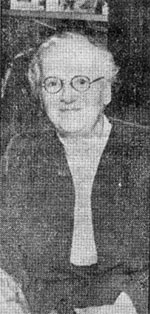 |
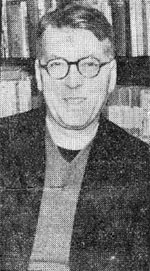 |
Miss
Banks: "Our greatest need is a new village hall," she says. |
The Rev.
J.H.Dobbs - a Vicar who lives in a rectory. |
|
I next called on Miss Banks
at Malt Cottage, who told me that the W.I. was 120 strong, had an excellent
dramamtic group and choir and gave demonstrations of handicraft and travel
talks. "The Rose Hill Residents' Association," she added, "also
put on socials and plays. I think our greatest need is a new village hall.
We do very much enjoy our social life and by no means all of us want to
be continually going into Oxford. We find that village life in Iffley
completely fills our needs." The sight of primroses and white roses in full flower by the churchyard wall at this time of year was as unexpected as it was pleasing. The church itself is lofty, with a stout, square Norman tower, and possesses neither transepts nor aisles nor side chapels. The vestry is in the rectory. The south, west and north doorways are all of exceptional interest owing to the intricacy of the ornate stone carving on the arches. The west door has no fewer than six superimposed orders. There are four arches of chevron pattern and two of twisted columns with fierce beak-headmouldings, surmounted by the sign of the Zodiac, the emblems of the Evangelists and other emblems. The south door, which is enclosed by a railing, has even more elaborate ornamentation, which includes figures of centaurs and mounted knights. IMPRESSIVE INTERIOR The Norman font, which is square and large enough to admit of infant immersion, has a shining top of black marble. In one of the windows I saw in ancient coloured glass, the armorial bearings of the Dukes fo Suffolk. It is the simplicity of this noble building that is, I think, its most striking feature. It is certainly one of the finest examples of Norman architecture in the country. VICAR IN RECTORY I wasn't surprised to learn from the Vicar, the Rev.J.H.Dobbs, that it is scheduled as an historic monument. "What does surprise me," I said, is to find a vicar living in a rectory. How does that come about?" "It goes back to the days," he replied, "when the Archdeacon of Oxford was the absentee rector and put a perpetual curate-in-charge. So though we live in the rectory we remain vicars or curates-in-charge." "To judge from the recent rate of increase in your parishioners," I said, "I should think that you would need several curates-in-charge." "It does create something of a problem," he replied, "when a parish of 800 suddenly expands to 10,000. The curious thing is that the village itself possesses no chapel. There is a Methodist Chapel on Rose Hill, but in Iffley itself only the church. My business is to get to know each of my 10,000 parishioners and to remind them of their beautiful mother church. My bell ringers (we have six lovely bells) also remind them twice every Sunday of the duty of worship, and everyone I call on is very friendly. We are a very neighbourly lot." A little further down Mill
Lane I called on Mrs. Wyatt who was born in the village and has lived
there all her life. "My father" she said, "was Joe Wilson,
village schoolmaster, choirmaster and owner of the famous Iffley Mill
which attracted so many generations of artists. The original Iffley Mill
dated back to before 1160. Our mill was a grist mill and was burnt down
in 1908. In those days we were cut right off from Oxford and had to walk
as far as Magdalen Road where the horse-trams began. As we lived in the
Mill House we spent most of our time on the river. |
|
|
|
|
Mrs.
Wyatt, who thinks all people in the village resent having to pay a toll to cross the river. |
Taking
the money at the toll gate. |
|
CELEBRITIES I continued my way down Mill Lane past the Manor House with its curious battlements and large verandahs, and Grist House, where the old mill stone stands outside the door, and having paid my 1d toll at Mr Gibbs' sweet shop, and crossed the bridge, where I watched a young man trying to propel an enormous tree that had been swept sown the river through one of the sluices with the aid of a very long boat hook. BUSY LOCK Iffley Lock is a very grand affair, complete with rollers, a deep lock, the main river passing over the sluice gates and a solid stone lock-keeper's house built in 1924. Mr Rouse, the lock-keeper, told me that between 2,500 and 3,000 boats pass through the lock each year. "Punts," he said, "are rapidly dying out, and power craft are increasing. Of course, about 100 years ago there was tremendous freight traffic, coal barges and so on - something like 40,000 tons in 1840, I'm told. That's all been taken over by road and rail." I asked him about accidents.
"A few weeks ago, we had to go to the rescue of the Oxford University
women's four, who were being swept by the current down to the weir. Men's
eights too often get into difficulties because they fail to read the warning
and come too far down. It's a strong and dangerous current." |
|
|
Mr. Rouse,
the lock-keeper, busy with an infrequent task - clearing the recent
snow from the lock. |
|
|
SUMMER VISITORS "We usually have a lot going on. Quite apart from being the starting point for Torpids and Eights, it's a favourite place for bathers and anglers, and in the summer, thousands of walkers make the circular tour down the towpath, over the toll bridge, up to the village and back along the Iffley Road. It's a pity that the fritilliaries, which used to grow in such abundance, have gone, but the poplars and willows still stand, and it's a good sight with all the little bridges and gardens by the waterside." One of the most remarkable personalities in Iffley today is Edward Cordrey, who has been a member of the church choir for 60 years and spends his leisure going round the district delivering his most fascinating talk on "Bygone days at Iffley." Whenever I raised any question about old Iffley, the answer invariably was: "You must ask Mr Cordrey about that. He is the great authority on old Iffley." "It's true," he said, "that I have a pretty retentive memory, and I've had my finger in most pies concerning the village. I've been secretary of most things in my time."
Mr.
Edward Cordrey, a chorister for 60 years |
|
|
FORMER SPORTS CLUBS I asked him first about games. "I used to be secretary of the Iffley Football Club. We had three XI's and played on Beri Mead, the large meadow opposite the lock, but that ceased about 20 years ago. Today Rose Hill have a fine football team, but Iffley has none. "Our cricket team used to play in the field opposite the Tree Hotel, which is now a kale field. That came to an end about 1905. There is a sports ground in Donnington Lane which is rented out to various clubs. Then we had a tennis club attached to the Institute. That was killed by the last war and never revived. Then further back we had our own rowing club and used to enter for the City bumping races. We were known as the Iffley Twisters, but that must have been 70 years ago." "This all sounds rather sad," I said. "What do the young people of Iffley do about games today?" "I suspect that the majority go into Oxford to watch other people play." "It sounds as if your greatest need is a new recreation ground." "The difficulty is to find a flat field which doesn't run the danger of being flooded." OLD CUSTOMS GONE "What about old Iffley customs?" "They have mainly died out, too. One of our great festivals was the Foresters' Club Day held in July, when the Foresters used to march in procession in sashes of red and green silk, with a band that played all day. There was a dinner in a marquee at the 'Tree' and a fair, and in the evening dancing on the green. We all had our Iffley Mummers who blackened their faces and dressed up in paper ribbons to act their play of King George and the Turkish Knight." "And we celebrated May Day in great style with the election of a King or Queen, a procession in which all the girls wore white dresses with pink or blue sashes and carried wreathes of flowers and the boys carried coloured wooden poles dressed with flowers and ribbons. There used to be about 40 in the procession, including the maids of honour, garlanders, guards, mace-bearers and so on. We had a service in church and a free tea for the whole school in the afternoon. All that's gone, too, though we revived it for the Festival of Britain." THE NOWELL SCHOLARS "There used to be a lot of charities. In 1805 Sarah Nowell left money for the free education of children, and the scarlet cloaks of the Nowell scholars added a lot of colour to the village. But this has been allowed to die. In 1678, Alice Smith left money for apprentices, and this has been carried on ever since. I was myself one of these last but out of the last 12 apprenticed from Iffley I believe that only two have stayed in the trade they were trained for." "I sometimes sigh for the days when the post van was heralded by a bugle and the postmistress used to bring round the letters, but in spite of many unavoidable changes, the appearance and spirit of Iffley remains much the same, and I for one could not have wished to have been brought up anywhere else." |
|